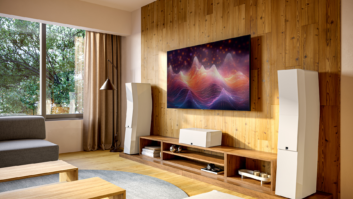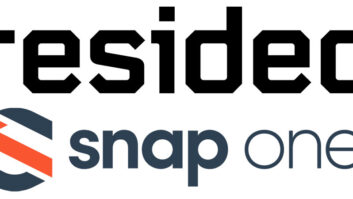These are exciting times for the custom installer involved in high-end residential control systems. In just the last 12 months we have seen an explosion of new high-quality, high-contrast color, standards-based touchpanels that can be used as mobile or in-wall touchscreens to control home automation and/or audio/video applications. As a dealer, it is important to review the product classifications in the touchscreen industry to decide on the optimal control interface for your customer’s applications.
The New Smart Displays: The new smart displays available from a number of different manufacturers (like Viewsonic, Compaq, etc.) are built upon an extension of the Windows CE.NET platform. Using Version 4.1 of CE.NET, manufacturers like Viewsonic are able to create a lightweight, mobile touchscreen that can serve as both a primary computer monitor as well as a mobile-computing interface panel. When the screen is detached from its docking bay at the computer it becomes a remote client to its host Windows XP Professional computer. This allows the screen to take full advantage of the processing power and hard-drive applications on the host computer wherever the display is used in the home. It communicates, like most of these mobile devices, over the wireless 802.11b standard so it can be used within a range of 75 to 150 feet from an access point. The benefit of this solution is the speed and responsiveness of the tablet, because it uses all the horsepower of its host and only needs to display and send screen images. The current disadvantage is that you are limited to one touchscreen display per host XP Pro computer. That makes this solution costly when several touchscreens are required for an installation. Microsoft recognizes this limitation and may upgrade its CE.NET 4.1/XP Pro offering later this year to include multiple client licenses for an additional fee.
Web Tablets: Web tablets come in a wide variety of form factors, weights, and prices. For an excellent overview (although a little dated) you can visit www.iapplianceweb.com/appDirectory/IAW_WEB_TABLET to compare and contrast many of the web tablets available on the market today. In general, most of these devices run the Windows CE 3.0 or CE.NET operating systems. Some web tablets run versions of Linux. The operating system is a critical component in the selection of these devices. It is always best to choose the web tablet with the most current operating system release. For example, web tablets running Windows CE 3.0 typically are running the older 4.0 release of Internet Explorer whereas the newer CE.NET tablets run the 5.5 release of Internet Explorer. This can become an important difference, because there are a number of plug-in browser applications (like streaming camera images) that are only supported in Internet Explorer 5.5 versions or higher.
Most web tablets are also very fast and responsive, because all of the applications and data are stored in flash RAM and not on an internal hard drive. These tablets also communicate to other devices on the network over an 802.11b interface and you can have multiple web tablet devices throughout a home mounted on individual recharging docking cradles. A typical home control application using web pads might be based on the Premise Systems software (www.premisesystems.com) package, where Premise displays the state of the home’s subsystems, lighting, thermostats and audio/video systems to a browser page that can be viewed and controlled at each webpad location.
Some companies, like CorAccess (www.coraccess.com), have extended the webtablet concept and have developed a housing platform to allow it to be mounted in the wall. In this configuration, the webpad touchscreen can always be in a powered state and communicate to the home network over a standard 10/100 ethernet Category 5 interface. The clear benefit of this configuration is that limited battery life and potential wireless distance or interference issues inherent to a mobile web tablet are eliminated. Obviously, one gives up mobility in exchange for this improved reliability. In my opinion, the ideal solution is to install a couple of in-wall panels in key locations in the home and complement these with the mobile web tablet displays on coffee tables or nightstand locations.
XP Tablet Edition Displays: The most sophisticated option for a touchscreen display (from an operating system and hardware perspective) is to utilize a web slate product running Microsoft’s XP Tablet edition software. This product is essentially a laptop with a touchscreen display. Many of the manufacturers in this product category have developed ingenious methods to either disguise or dispose of the keyboard when these computers are in their touchscreen mode. Some companies, like Acer, have introduced a laptop screen that tilts and twists around to lie on top of the keyboard. Other companies, like HP-Compaq, have developed a product that allows you to completely detach the touchscreen from the keyboard. The benefit of these products is that you have a full-featured and robust operating system (Microsoft XP) on the touchscreen, plenty of memory and a full 20 or 40 GB drive. You can also benefit from the dual-functionality of these products; they are fully working laptops in addition to providing a high-resolution, high-contrast color home control touchscreen interface. If your customer needs a new laptop and you are developing an integrated touchscreen-based home control system for your client, this may be the ideal solution. The disadvantage of these platforms is that will always be heavier and more costly than the web tablets.
Personal Digital Assistants and WAP Enabled Phones: This last category represents the smallest and lightest weight form factors for home control touchscreens. In many cases, we are beginning to see these devices merge into one mobile device (such as the ones offered by T-mobile). They will typically operate on the Microsoft Pocket PC 2002 or Palm operating systems. The key benefit of these devices, besides their convenient size and weight, is their wide range of mobility. All of the previous control screens can only work within the range of a wireless 802.11b signal or are tethered by a Category 5 wire for the in-wall devices. These mobile devices can use cellular technology to provide Internet access to their small screens. As a result, your customer could access the browser control page of their home automation network while they are on the road and activate a lighting or heating application (for example). The disadvantage of these smaller devices is the limited real estate on the screen reduces the number of home control options that can easily be displayed and controlled.
Similar to most custom electronics design decisions, there is no one correct answer that fits all situations. The decision as to which touchscreen to use is no different. For some clients, one could envision a scenario where each of the above tablets would be appropriate for a large installation with a variety of applications. What is unique today is that the integrator can now offer a rich, wide variety of touchscreen panels to satisfy a wide range of customer needs. The home control interface can now integrated into a family of data-connected products in the home and provide far greater functionality and flexibility than the few, select, proprietary home control interfaces that existed in the market just a few years ago. That is great news for the customer and for the integrator who can tailor a touchpanel control solution that fits all the needs of his/her networked clients.
Gordon van Zuiden ([email protected]) is president of cyberManor, in Los Gatos, California.







